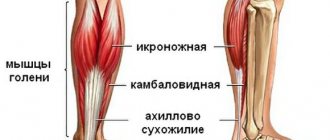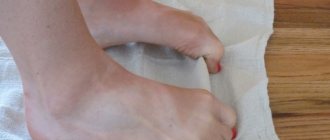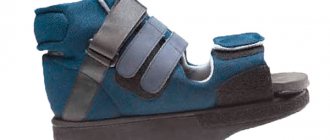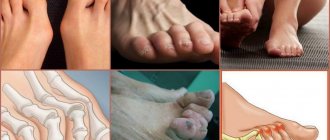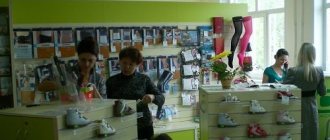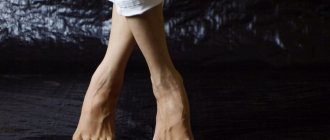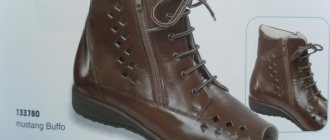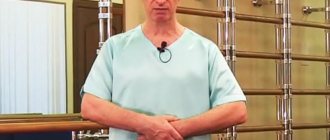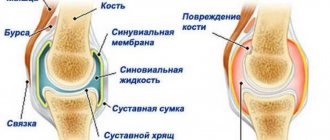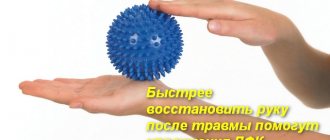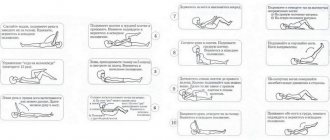Hallux valgus is not a one-time lesion of the musculoskeletal system, leading to inconvenience and limitations in physical activity. “Wrong” development occurs gradually. Surgical intervention is rather a necessary measure to completely eliminate the problem in the later stages of foot deformity.
If we promptly monitor the appearance of disturbing symptoms, what measures will help? It has been proven that special exercises have become one of the best treatment options for hallux valgus.
They are aimed at strengthening and supporting cartilage and joints, normalizing metabolic processes, correcting the position of the foot and counteracting the development of curvature.
Physical therapy, or exercise therapy, is the most important component of the treatment of hallux valgus, which is fraught with complications when walking.
This gymnastics itself is shown at any age:
- Babies under 8-18 months will benefit from specialized therapeutic massage.
- Children who have already begun to walk should be introduced to a set of exercises and do it with them.
- Adults should psychologically accept the need for change - and constantly perform therapeutic exercises to prevent deterioration.
A set of exercises for the prevention of hallux valgus
Specially selected exercises (provided they are performed regularly and completely) will “work” simultaneously in two directions: gradually eliminate the deformity and ensure the prevention of valgus.
- Starting position: lying on the floor. Exercise – “bicycle” (imitation of riding, try to keep your legs parallel to the floor).
- Starting position: sitting on the floor, emphasis on arms outstretched, legs straightened, gradual flexion at the ankle.
- Spread the toes as far apart as possible. Next, open and close them as quickly and as forcefully as possible.
- Starting position: sitting on a chair, move your feet only with your fingers, spreading your legs.
- Insert and hold a pen between your thumb and index finger (it can be a stick, pencil, etc.). With a clamped object, make circular movements, draw numbers or letters.
- Starting position: standing. Walk several circles, alternating steps on your toes, heels, and the outer and inner ribs of your feet. The arms are raised vertically, straightened.
- Starting position: sitting on a chair, collect a ribbon, rope or piece of fabric with your toes. Also sort through small items.
Adults will have to perform the complex in the mornings and evenings (repeating each movement 5-7 times) according to the scheme: course from 2 weeks to a month - a month break. Your doctor will help you choose exercises, as well as additional therapy.
Correction Methods
It is important to start fighting deformation in time. Basically, this is exercise therapy for hallux valgus in children, massage.
Thanks to a special complex, therapy confidently fights this disease. Exercise therapy helps the youngest patients faster and more effectively. After all, their tissues (cartilage, articular, bone) are still very elastic, soft, and easy to adjust.
Regular, systematic exercise therapy for flat-valgus feet in children will help to quickly achieve improvements and completely eliminate the problem.
Their main use is to correct curvatures.
Exercise therapy gives the following results:
- removes feelings of discomfort and heaviness in the legs;
- relieves pain, swelling;
- strengthens muscle groups, ligaments;
- normalizes blood circulation in the muscles;
- corrects the foot (it becomes anatomically correct);
- prevents pathology from progressing;
- corrects gait;
- acts as a prevention of various complications (for example, flat feet).
Important! Visit the physical therapy room several times a week. Do physical exercises with your baby every day at home.
Physiotherapy for hallux valgus
Physiotherapy is an additional component designed to reduce or completely stop pain syndromes, restore mobility of the foot joints, activate basic metabolic processes, and reduce the risk of complications. It is important to remember that procedures are ineffective if you try to be treated only with their help. Rehabilitation will provide improvements when the right set of measures is selected.
The range of physiotherapy methods for severe foot deformities is unusually wide. A patient with a hallux valgus may be recommended shock wave therapy, mud therapy, correction with a laser, treatment with ultrasound, magnets, electrophoresis, and sinus-modulated currents. The maximum physiotherapeutic effect will be for stages 1 and 2 of hallux valgus.
Shock wave therapy (SWT) is based on the use of waves of an acoustic nature according to the principle of harmless “impact-repulsion”. Penetrating through the tissues of the muscular system, the waves have a positive effect on bones, cartilage, and joints. They are able to remove congestion, hallux valgus, and increase metabolism, blood flow and oxygen saturation.
Laser is a relatively new procedure. It is based on the effect of laser radiation and heat on the cells of the damaged area of the foot (calcium ions are released, fibrin protein is more actively absorbed from the blood plasma, and blood circulation is stimulated). Helps eliminate swelling and inflammation, promotes the disappearance of growths.
Ultrasound is also widely used to get rid of this type of deformation. The desired therapeutic effect is achieved by local heating under the influence of the device; increased collagen production is stimulated in the muscles and joints, swelling and redness disappear.
Treatment of hallux valgus with mud is based on thermal effects. Therapeutic mud is heated and applied as a compress to the affected area. The method gives greater effect in combination with massage. The mechanism of action (like a warm compress on a hallux valgus) is similar to paraffin and ozokerite applications.
Magnetotherapy – a physiotherapeutic effect is carried out using a magnetic impulse, which accelerates blood circulation in certain areas, reduces pain, and has an anti-inflammatory effect.
Electrophoresis is a combined injection of a medicinal substance (for example, calcium needed by the body) to the desired area through current.
Electrical stimulation is a treatment method using muscle stimulation with currents. Helps relieve pain and normalize muscle function.
It is impossible to choose the appropriate type of physical therapy for types of foot deformities on your own. The fact is that each method is effective in different ways, and, in addition to healing elements, it also involves contraindications. The choice of the type of influence, duration of the course, and correction of treatment remains with the physiotherapist.
BEFORE and AFTER surgery on a deformed foot
Patients often ask when it is more beneficial to do exercises - before or after surgery. Doctors here are unanimous: it is optimal to perform gymnastics constantly. If surgery has taken place, classes should be excluded in the first two weeks. The body needs to recover during the healing period of wounds and stitches. From the third week, daily exercises are added to the rehabilitation course, the load increases moderately. After a month and a half, you are allowed to switch to the full volume. The complex includes a number of exercises:
- collect and mix small objects with your toes;
- lift and move a ball or similar, not heavy, rounded element;
- “caterpillar” - imitate the movement of a given insect with the sole and fingers;
- “draw” simple contours, for example, numbers, with your toes;
- roll the ball with your foot in different projections: back and forth and in a circle.
Exercises after surgery
If an operation was performed to remove a lump, then gymnastics is an important measure in rehabilitation. Exercises should be performed every day, this will make it possible to develop the thumb, prevent the formation of adhesions and speed up rehabilitation.
There is no point in doing exercises during the first two weeks after surgery; exercise begins from the third week.
The gymnast begins with movements of moderate intensity. Grab your thumb near its base. Gently pull it towards you until you feel resistance and slight discomfort. Hold your finger in this position for ten seconds. Repeat the exercise three times. Then do the same in a downward direction. Do this three times too.
During the fourth week, this exercise is performed three times a day.
In the fifth and sixth weeks after surgery, the same exercises are done, but repeated more times. By the end of the sixth week it is brought to six. The intensity of execution and amplitude of movement increases gradually.
From the seventh week, exercises begin that put a load on the foot with the weight of your own body. In a standing position, you need to lift your heels up without lifting your toes from the floor. Hold this position for ten seconds (or less if it is very difficult). Then calmly lower your heels.
After the seventh week, walking uphill (optionally, on a treadmill) is recommended. Another effective exercise is walking with long strides, which helps expand the range of motion of the foot joints that require development.
Another exercise that is recommended to be performed after the seventh week. It is similar to the first, but with one hand you need to fix the foot, and with the other, first stretch your finger forward, and then pull it up and fix it in this position for ten seconds. Do the exercise three times, then repeat it in the downward direction. The foot itself should be kept straight.
Exercises should be done regularly, this will help speed up the rehabilitation process and restore full movement in the joints.
A set of exercises for children
The sooner a child with suspected hallux valgus or with an already established diagnosis begins to correct the lesion through physical therapy, the more noticeable will be the prevention of further curvature of the foot. The key to recovery and success here is the precision and continuity of approximately 20 minutes of exercise.
Experts recommend performing a set of exercises for hallux valgus for children barefoot or wearing thin cotton socks.
It is important to form the right attitude towards exercise in your child. So that he does not refuse classes, it is preferable to conduct them in a playful way (or introducing a competitive element), in a positive way. Don’t be afraid to help him at first, give him hints, hold him a little if it’s difficult to fix himself in the right position. I advise you to give pleasant and understandable names to the exercises. For example, call the steps on the outside of the sole “bear-toed”, imitation of the gait of a bear. They will be replaced by walking on a relief surface (place a tape or a special mat). It is useful to restore motor skills by lifting small objects with your toes: these can be small toys, Lego or similar bricks, handkerchiefs, pens and pencils. You can complete the exercise with squats: keep your feet parallel to each other and not lift them off the floor.
Monitor the load and adjust it; the complex can be divided into several approaches. In the first days, sessions should not be long; increase the duration gradually, under the supervision of the attending physician or exercise therapy instructor.
What is planovalgus foot in a child?
This is a deformity where the toes and heels are deviated outward. An internal curvature in which the arch of the foot is reduced. Children with this feature have an abnormal gait and quickly get tired when walking.
Children with this pathology are prone to arthritis, arthrosis, various joint deformities, and flat feet.
The deformity can be congenital or appears when muscle ligaments are weakened, there have been injuries, polio, or rickets.
To accurately determine the presence of a deviation, wet the baby’s feet and place them on a piece of paper. Outline the feet. If the arch of the foot drops on the print, it is visible on paper (“Bigfoot print”), then this is the main sign of plano-valgus. This cannot happen in healthy legs.
Diagnostics must be carried out periodically in order to notice the development of deformation in time. It is better to do it playfully. Make colorful footprints with your baby (dilute special safe paint in water).
Note! To clarify the diagnosis, be sure to consult with an orthopedist.
The effectiveness of exercise will increase in combination with other measures
Daily exercise strengthens ligaments and muscles, eradicates pain, and returns joints to their natural position. What can be supplemented with it?
- Take care of the comfort of your feet and make it a rule to wear only comfortable shoes, avoid tight pairs. Recommendations for women: choose stable street and casual shoes (especially shoes and boots) with low, reliable wedges. Ideally, of course, choose orthopedic shoes.
- Also talk to your doctor about what type of corrective orthotics you can wear. Patients with more pronounced changes are prescribed special rehabilitation means - pelota and orthoses.
- Do an additional massage of the feet and legs.
- Brew foot baths with sea salt or pine extract.
- Prevention of hallux valgus should include diet. Proper nutrition, selected and fit into your schedule, will help maintain the proper balance and metabolism of minerals, vitamins, microelements, and proteins. It is advisable to consume less foods high in purines (organic compounds, the breakdown of which forms uric acid): these include tea, chocolate and coffee, strong broth, legumes, meat and seafood. They cannot be excluded, but it is quite possible to balance the intake.
- Separately, discuss exercise with your doctor: reasonable maintenance physical activity is needed. Swimming and cycling are recommended for almost everyone; other disciplines are best assessed from the point of view of their impact on the lower extremities - whether they will provoke complications of valgus deformities of the foot.
We hope that the general recommendations were useful. It is much easier for doctors and patients to work together to cope with the manifestations of deformities in the early stages and prevent their more severe course! The specialists at Dr. Begma’s clinic are ready to conduct a consultation about the health of your feet and choose the most effective and suitable set of therapeutic or preventive effects for you.
